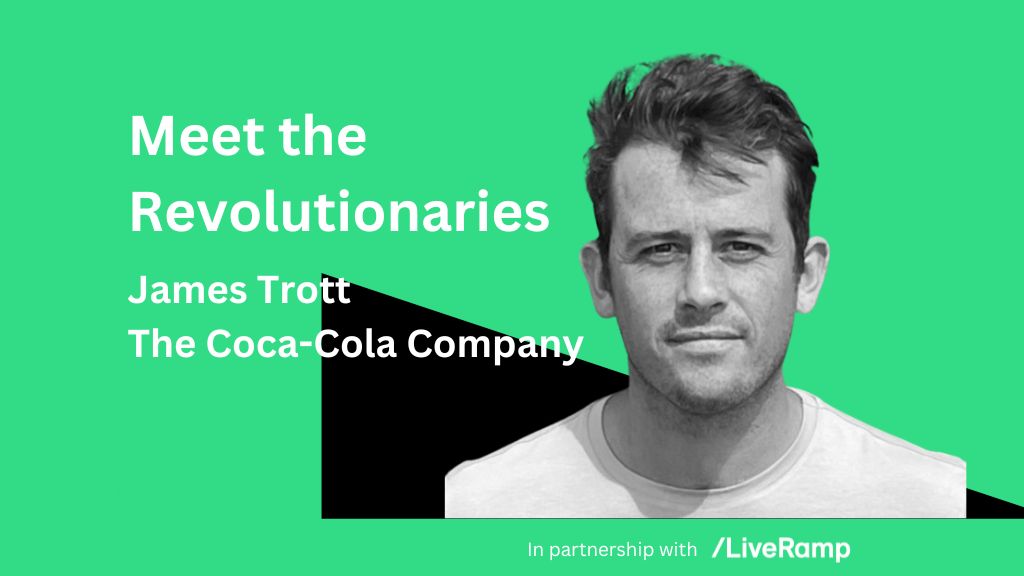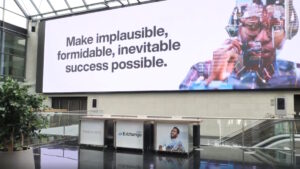New Digital Age (NDA), in association with LiveRamp, is spotlighting the men and women championing a data-led revolution in the marketing industry. ‘Meet the Revolutionaries’ focuses on the efforts of the industry executives helping to push digital marketing into a new era of data collaboration.
Here, James Trott, Senior Director of Audience Planning and Global Addressable Media at The Coca-Cola Company outlines the questions he asks himself before embarking on any innovation-based project…
Tell me about your current role and how your career has led you here.
My remit is to make sure that our programmatic and addressable media campaigns perform as well as they possibly can. There are two main parts to the job, which I call ‘raising the floor’ and ‘raising the ceiling’.
Raising the floor refers to raising the minimum standards and expectations of our campaigns and setting best practices to ensure that our minimum standards are always in place. Raising the ceiling relates to how we leverage or build new products, solutions and capabilities that can be used to drive exceptional results on any given campaign.
Before joining The Coca-Cola Company, I was agency-side for 12 years, working with Havas, Dentsu and IPG, in roles mostly focused around programmatic strategy, planning and buying, working with clients including Microsoft and Diageo.
When the chance came to join Coca-Cola I was excited to apply my skills and knowledge in a client-side position and join a truly global business. It’s an amazing place to work.
Can you give an example of a time when you personally have helped to drive innovation?
In my experience, marketers have an unquenchable appetite for the new so there are a few examples but a good one is that, a few years ago, I became slightly obsessed with reducing the amount of overlap and wastage seen with TV and video campaigns. Let’s say you have a campaign budget that is split 60% to linear TV, 20% to CTV and 20% to YouTube and other online platforms. There’s going to be a lot of overlap in terms of exposure to the campaign in some areas and some gaps in others.
We worked on a project with a variety of partner companies that allowed us to work out which postcode areas in the UK were over- or under-indexing for linear TV viewing. Where linear TV was under-indexing, we would boost the volume of spending on YouTube in those particular areas to plug any gaps, which produced some great results for us, delivering incremental reach through smart digital buying.
What are the most common challenges or barriers to innovation?
I’ve always had a system, a set of criteria, I use to determine whether an idea is worth pursuing. If the answer to any two of the following questions is ‘no’ the idea is probably not going to get off the ground.
Number one, do you have a simple and clear value proposition? People need to be able to understand whatever you’re proposing, quickly, or it won’t happen.
Secondly, is the idea widely applicable? Will it influence something significant? If your idea only impacts or affects a small, niche area of the business, it won’t gain a lot of attention among key stakeholders.
Thirdly, do you have a clear measurement framework to assess the success of your idea? That normally means having a ‘journey-based’ framework to measure yourself against, i.e. we started there and now we are here.
Finally, does the idea or change you want to implement have extraordinary value for your organisation?
If you can answer ‘yes’ to at least three of those, for me, the idea is worth taking further.
What tips can you offer others hoping to drive innovation?
I think if you’re naturally an inquisitive person with a curious mind, you’re probably quite well suited to driving innovation.
For me, whenever you’re trying to build a business case for innovation, the main thing is to have real conviction about it. You need to believe 110% that this is a good idea worth people’s time and attention. Innovation, at heart, is about doing things differently from how they’re done at the moment and encouraging people to do something new, rather than the thing they are comfortable with.
You need a compelling case to move things forward. You’ve got to really articulate what the problem is, what your solution is, and, and how you can deliver that with the minimum amount of input or investment required from stakeholders.
How do you think digital marketing might evolve over the next few years?
I’m from a media background, so I can foresee a time when we give Artificial Intelligence (AI) the keys to making media investment decisions and creative optimisation decisions at scale. When we talk about Dynamic Creative Optimisation right now, we’re typically talking about serving one of maybe 30 different iterations of an ad to a person based on their data signals. I envisage a future where DCO is possible on a one-to-one basis with each individual recipient of an ad being served their own unique version based on their personal preferences.
Sustainable practices are going to come to the fore. There are significant business benefits to cleaning up your media supply chain as well as it being the right thing to do for the planet.
Attention, for me, will probably become the default way that we optimize towards media. It’s a very nice, neat and elegant way of cutting through the clutter and noise to know that you’re buying medium-to-high attention placements.
I also think Blockchain solutions are going to come to the fore in media buying as well. Blockchain buying really suits programmatic and addressable media. The idea that all transactions are available on a public ledger basically cuts out the potential for ad fraud. Right now, there’s a good chance that there’s a lot more ad fraud out there than we know about.
Will data collaboration become more important to marketers?
When data collaboration becomes quicker, more seamless, and generally easier to do, it will scale massively, particularly among brands that don’t have much depth of data. They might have a fair amount of first party data, say customer email addresses, but don’t actually know much about their audience or understand how best to talk to them. Combining your own data with other datasets to learn more about your customers is a really interesting and, potentially, really powerful tool to have at your disposal.












